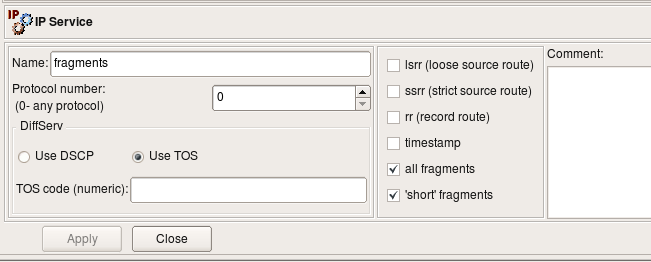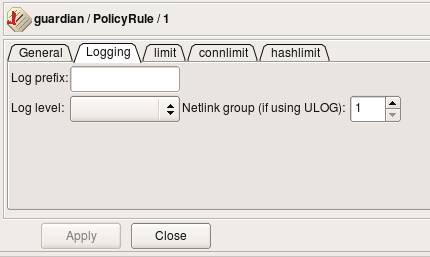Search Users Guide
Fragmented IP packets, although useful in certain situations, are often used as a tool to probe and penetrate simple packet filters. Particular kinds of fragmented packets, namely those with incorrect length specifications, are especially bad because they can cause some operating systems to crash (for example Windows NT was known to crash before a fix was developed and published by Microsoft). These packets therefore are considered potentially harmful and should be blocked on the perimeter of your network. Many firewall platforms provide ways to deal with such packets.
In Firewall Builder, we provide a way to set flags or options in the IP service object. Two options deal with fragments: one is called "all fragments" and another "short fragments". Figure 14.32 shows how a user-defined object called "fragments" looks with both options turned on. Policy compilers recognize this object and generate correct code for underlying firewall software platform.
The "ip_fragments" object, which is included in the section "Services/IP" of the Standard objects tree, is set to block "short" fragments only.
Another potentially harmful type of packets is so called "Christmas tree" packet. This one is just a TCP packet with an impossible combination of TCP flags or even all TCP flags turned on at once (for example SYN, ACK, FIN, RST, PSH). This combination is never used in real communications, so if a packet like that appears at the boundary of your network, it should be considered illegal and blocked. Object "tcp-xmas" is included in the section "Services/TCP" of the standard objects database coming with Firewall Builder.
Some platforms provide a mechanism to turn on and off stateful inspection on individual rules. Turning it off on those rules which do not require it may improve performance of the firewall. Obviously, we do not need stateful inspection while analysing fragmented packets as we do not really want any session to be established, so we can safely use this option on this rule. One example of firewall platform which supports stateful inspection but provides a way to turn it on and off is iptables. In Firewall Builder, this can be done in the rule options dialog (which is platform-sensitive and shows different options for different platforms). Figure 14.33 shows rule logging options dialog for iptables:
Here is an example of the policy rule which is intended to block short fragments and TCP "Christmas scan" packets. The icon in the Options column indicates that logging is turned on.
This rule applies to all packets crossing the firewall regardless of their origin. This means that it will block such packets originating in your network, too. If by some reason you might want to be able to send this kind of packets out, then specify your external interface in the Interface column.
Copyright © 2000-2012 NetCitadel, Inc. All rights reserved.
Using free CSS Templates.



